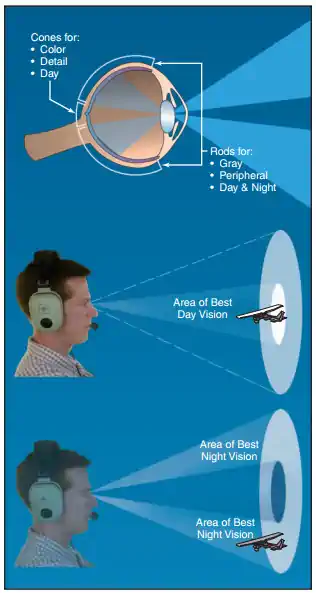Night and Peripheral Vision Depend Mainly on
If you project a red a green and a blue light into space the point at which the three lights cross will lead to the perception of white light. Night and peripheral vision depend mainly on rods while daylight and acute vision depend mainly on cones.
The opposite conditionthe loss of your central vision while retaining your peripheral visionis known as central scotoma.
. Night and peripheral vision depend mainly on _____ while daylight and acute vision depend mainly on _____. The peripheral vision or indirect vision is the side vision that allows the eye to view objects on either side. Dark adaptation which is necessary for night vision is the process by which eyes increase their sensitivity to low levels of illumination.
Most people do not appreciate their peripheral vision until they begin to lose it. Night and peripheral vision depend mainly on _____ while daylight and acute vision depend mainly on _____. Both rods and cones contain photopigments which on exposure to light undergo a chemical change that initiates visual impulses in the retina.
The peripheral retina the part of the eye that detects light is actually more sensitive to low light levels then the central retina. Peripheral Vision LossDefinitionPeripheral vision loss is loss of the range of view or field that allows a person to see movement and objects out of the central line of sight. The common equation of scotopicrod vision with night is an error.
Sometimes peripheral vision loss is referred to as tunnel vision. Look slightly to one side. The loss of peripheral vision results in a condition known as tunnel vision.
Peripheral vision mainly depends upon. As we have outlined in the introduction peripheral and foveal vision differ in many aspects and for the most part peripheral vision achieves the ability to represent a large portion of the visual field by giving up the ability to represent all the elements that it might contain individually and with high acuity. Which receptors are responsible for the perception of color.
What is the name of the illusions when the figure and background can switch. Source for information on Peripheral Vision Loss. Rod cells are responsible for peripheral vision and night vision while cone cells react to brighter light color and fine details.
Where is the blind spot in the eye. Peripheral vision is weaker in humans than in many other species and this disparity is even. Question 79 Multiple Choice 0 points Modify Remove Question In order to maximize visual acuity at night.
A patients fear outbursts are found to be caused by pressure applied to the brain by a tumor. Humans can hear sounds ranging in _____ from 20-20000 Hz mice can hear sounds ranging from 1000-70000 Hz bats can hear sounds from 1000-200000 Hz and cats can hear sounds ranging from 55-79000 Hz. 64k views Reviewed 2 years ago.
In urban environments there is enough ambient light at night to prevent real scotopic vision. Where the optic nerve exits the back of the eye. With the help of a friend you can measure how much you can see out of the corner of your eye.
Question 78 Multiple Choice 0 points Modify Remove Question Night and peripheral vision depend mainly on ____ while daylight and acute vision depend mainly on ____. This is why nighttime hikers will look slightly above the trail to find their way and pilots learn to look for traffic. Vision begins when electromagnetic wave energy enters the eye through the cornea and pupil and is focused on the retina by the lens.
When light hits its corresponding rod or cone the cell activates firing a nerve impulse through the optic nerve the middle man between the eye and the brain. Test the limits of your peripheral vision with a homemade version of a protractor. The Gale Encyclopedia of.
Yes this is true for everyone although most people dont realize it. Peripheral vision is a result of different nerve cells and rods located outside of the macula. This reinforces the fact that night vision depends less the individual photoreceptors and more on the way that they are wired together.
According to the trichromatic theory of color vision. At night the peripheral retina sees better than the central retina. Night and peripheral vision depend mainly on ____ while daylight and acute vision depend mainly on ____.
Night and peripheral vision depend mainly on _____ while daylight and acute vision depend mainly on _____. Night vision scotopic vision 46 Dark adaptation. Cone cells B cone cells.
Night and peripheral vision depend mainly on _____ while daylight and acute vision depend mainly on ____. Our peripheral vision is much better than our foveal strait-on vision at night because our photoreceptors that react best to dim light rod cells are primarily located in our retinas periphery. Peripheral Vision at Night.
Where is the tumor most likely to be found. Cone cells The fact that you see as two sets of three parentheses instead of one set of six parentheses can be explained by the gestalt law of _____. If you wanted to see a faint star at night you should.
Night and peripheral vision depend mainly on ____ while daylight and acute vision depend mainly on ____. Youll find that you can detect motion color shape and text at different angles. The amount of light entering the eye is regulated by changes in the size of the pupil.
Peripheral vision allows a person to view objects around them without having to move their eyes or head. The effect is a constricted or tunnel-like range of vision.
What Is Peripheral Vision Loss And What Is It Like To Experience It Do People See Black At The Sides Of Their Vision Or Is It More Subtle Than That Quora



No comments for "Night and Peripheral Vision Depend Mainly on"
Post a Comment